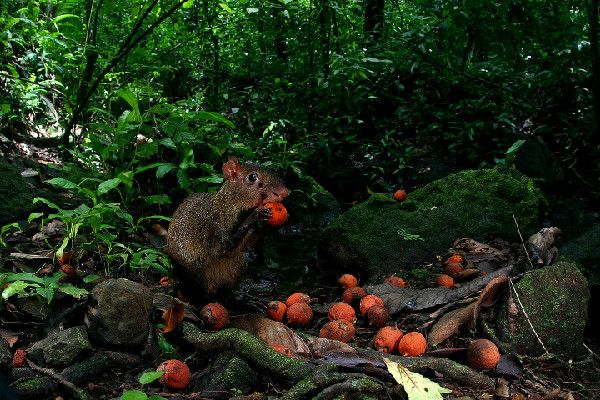Thieving Rodents Explain Tree Survival Mystery

Large-seeded trees in the American tropics have posed a mystery: How have the young trees survived, when local wildlife can’t swallow the fruits and seeds whole and transport them away from the parent tree?
The fruits can be up to 4 inches (10 centimeters) in diameter, and researchers have proposed that, many millennia ago, the enormous animals of the Pleistocene, including the relatives of elephants and mastodons, did the job of consuming the fruit and dropping the seeds elsewhere. But those animals are long gone, and today, smaller animals inhabit the region.
Now, scientists report they’ve found the seed spreader: thieving rodents.
Rodents, such as rabbit-size agoutis, carry away seeds and bury them, creating caches of stored food. Until now, scientists didn’t think rodents such as agoutis were up to the task of handling the large seeds. For one thing, the animals didn’t appear to carry the seeds far enough away from the parent tree to give seedlings a good shot at establishing themselves.
But prior work didn’t take agoutis’ thieving ways into account.
An international team of researchers, led by Patrick Jansen of the Smithsonian Tropical Research Institute, followed the fate of 589 black palm seeds on Panama’s Barro Colorado Island by attaching transmitters to the roughly 1.2-inch (3-centimeter) long seeds, with the orange fruit scraped off. They also followed the movements of 16 clearly identifiable agoutis, and monitored 154 agouti caches with remote cameras for a year.
They found that the agoutis raided each others’ caches, moving seeds to new locations, which were themselves then plundered by other agoutis.
Sign up for the Live Science daily newsletter now
Get the world’s most fascinating discoveries delivered straight to your inbox.
One seed was hidden as many as 36 times, traveling more than 2,460 feet (749 meters), and ending up 920 feet (280 m) from its starting point, when it was dug up and eaten 209 days later, the researchers write in results published online today (July 16) in the journal Proceedings of the National Academy of Sciences.
This thievery moved an estimated 87 percent of seeds beyond the immediate vicinity of the parent tree, according to the study.
What’s more, only a fraction of the seeds removed from the initial cache — about 13 percent — were eaten, and an estimated 14 percent of cached seeds survived to the next year, when new fruit became available to distract the rodents, they found.
Rodents and large-seeded plants such as the black palm have a very old relationship that dates to before the Pleistocene, the researchers noted.
"These plants may have a long history of seed dispersal by rodents, and perhaps never depended on megafauna (large animals) in the first place," they concluded.
Follow Wynne Parry on Twitter @Wynne_Parry or LiveScience @livescience. We're also on Facebook & Google+.













